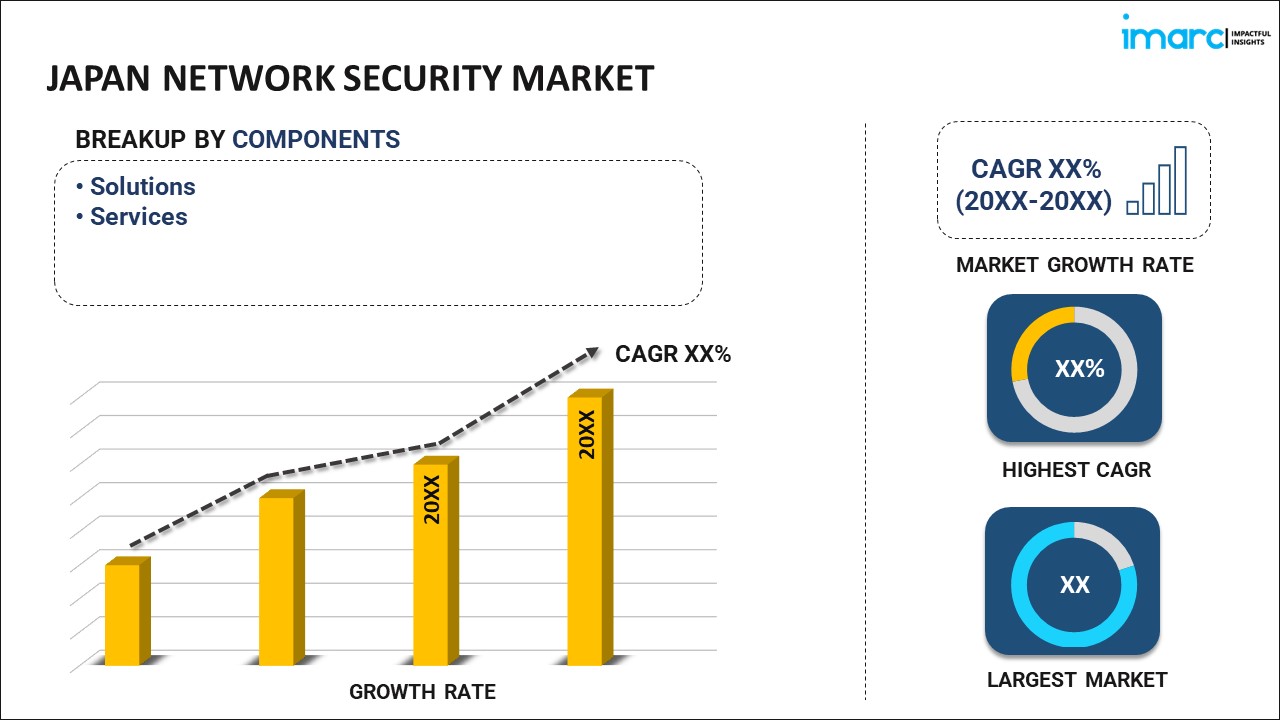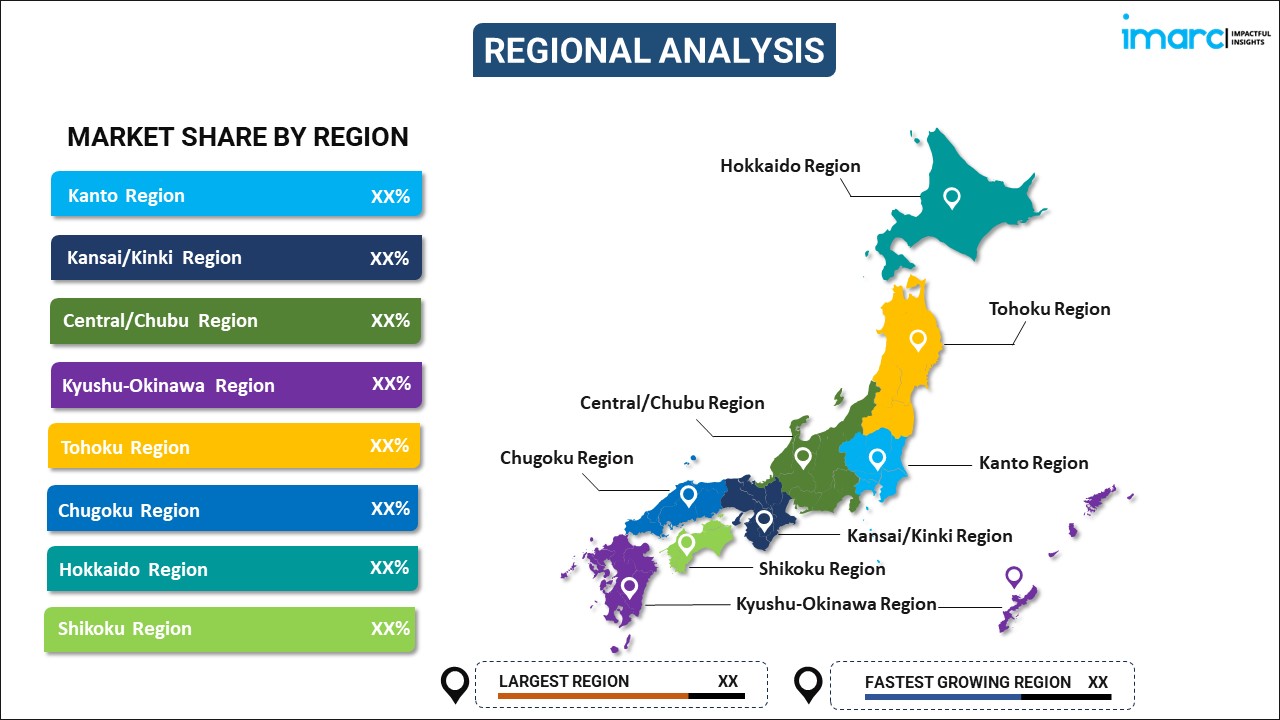
Japan Network Security Market Report by Component (Solutions, Services), Deployment Mode (Cloud-based, On-premises), Organization Size (Large Enterprises, Small and Medium-sized Enterprises), Industry Vertical (IT and Telecommunication, BFSI, Aerospace and Defense, Government, Healthcare, Retail, Manufacturing, Energy and Utilities, and Others), and Region 2025-2033
Market Overview:
Japan network security market size reached USD 2,414.7 Million in 2024. Looking forward, IMARC Group expects the market to reach USD 6,442.3 Million by 2033, exhibiting a growth rate (CAGR) of 11.52% during 2025-2033. The rising incidences of cyberattacks across various industries, the proliferation of connected devices and the advent of the Internet of Things (IoT), and the emerging popularity of cloud computing represent some of the key factors driving the market.
|
Report Attribute
|
Key Statistics
|
|---|---|
|
Base Year
|
2024 |
|
Forecast Years
|
2025-2033
|
|
Historical Years
|
2019-2024
|
| Market Size in 2024 | USD 2,414.7 Million |
| Market Forecast in 2033 | USD 6,442.3 Million |
| Market Growth Rate (2025-2033) | 11.52% |
Network security encompasses a set of measures, practices, and technologies designed to protect computer networks, systems, and data from unauthorized access, cyberattacks, and other security threats. It serves as the digital barrier that shields organizations, businesses, and individuals from the ever-evolving risks posed by malicious actors in the cyber realm. It involves a multifaceted approach that involves the establishment of robust access controls, ensuring that only authorized users can access sensitive data and resources. This includes user authentication mechanisms like passwords, biometrics, and multi-factor authentication (MFA) to verify the identity of users. Additionally, encryption plays a crucial role in network security by transforming data into unreadable formats that can only be deciphered by authorized parties with the appropriate decryption keys. Firewalls are another integral aspect of network security, acting as gatekeepers that monitor and filter incoming and outgoing network traffic. They are designed to permit or block data packets based on predetermined security rules, thereby preventing unauthorized access and malicious activities. Furthermore, network security extends to the realm of virtual private networks (VPNs), which enable secure communication over untrusted networks, such as the internet. VPNs create encrypted tunnels through which data can travel securely, safeguarding it from interception by cybercriminals or eavesdroppers.
Japan Network Security Market Trends:
One of the primary drivers of this market's expansion is the escalating frequency and sophistication of cyberattacks. With cybercriminals constantly devising new tactics and strategies, organizations are compelled to invest in advanced Network Security solutions to defend against evolving threats. The rise of ransomware attacks, data breaches, and malware infections has underscored the critical need for robust Network Security measures. Another key driver in the market is the proliferation of connected devices and the advent of the Internet of Things (IoT). The increasing number of IoT devices, ranging from smart appliances to industrial sensors, has expanded the attack surface for cybercriminals. Consequently, businesses are deploying network security solutions that can secure IoT devices and networks, ensuring the integrity and confidentiality of data transmitted and received by these interconnected devices. Cloud computing adoption is also influencing the network security landscape. As more organizations migrate their operations to the cloud, they require cloud-native security solutions that can protect data and applications hosted in virtual environments. Moreover, the network security market is witnessing a shift toward artificial intelligence (AI) and machine learning (ML) technologies. These advanced technologies are being integrated into network security solutions to enhance threat detection and response capabilities. AI and ML can analyze vast amounts of network data in real-time, identifying anomalies and potential security breaches faster and more accurately than traditional methods.
Japan Network Security Market Segmentation:
IMARC Group provides an analysis of the key trends in each segment of the market, along with forecasts at the country level for 2025-2033. Our report has categorized the market based on component, deployment mode, organization size, and industry vertical.
Component Insights:

- Solutions
- Firewalls
- Antivirus/Antimalware
- Network Access Control (NAC)
- Data Loss Prevention
- IDS/IPS
- Secure Web Gateways
- DDoS Mitigation
- Unified Threat Management
- Others
- Services
- Professional Services
- Managed Services
The report has provided a detailed breakup and analysis of the market based on the component. This includes solutions (firewalls, antivirus/antimalware, network access control (NAC), data loss prevention, IDS/IPS, secure web gateways, DDoS mitigation, unified threat management, and others) and services (professional services and managed services).
Deployment Mode Insights:
- Cloud-based
- On-premises
A detailed breakup and analysis of the market based on the deployment mode have also been provided in the report. This includes cloud-based and on-premises.
Organization Size Insights:
- Large Enterprises
- Small and Medium-sized Enterprises
The report has provided a detailed breakup and analysis of the market based on the organization size. This includes large enterprises and small and medium-sized enterprises.
Industry Vertical Insights:
- IT and Telecommunication
- BFSI
- Aerospace and Defense
- Government
- Healthcare
- Retail
- Manufacturing
- Energy and Utilities
- Others
A detailed breakup and analysis of the market based on the industry vertical have also been provided in the report. This includes IT and telecommunication, BFSI, aerospace and defense, government, healthcare, retail, manufacturing, energy and utilities, and others.
Regional Insights:

- Kanto Region
- Kansai/Kinki Region
- Central/ Chubu Region
- Kyushu-Okinawa Region
- Tohoku Region
- Chugoku Region
- Hokkaido Region
- Shikoku Region
The report has also provided a comprehensive analysis of all the major regional markets, which include Kanto Region, Kansai/Kinki Region, Central/ Chubu Region, Kyushu-Okinawa Region, Tohoku Region, Chugoku Region, Hokkaido Region, and Shikoku Region.
Competitive Landscape:
The market research report has also provided a comprehensive analysis of the competitive landscape. Competitive analysis such as market structure, key player positioning, top winning strategies, competitive dashboard, and company evaluation quadrant has been covered in the report. Also, detailed profiles of all major companies have been provided.
Japan Network Security Market Report Coverage:
| Report Features | Details |
|---|---|
| Base Year of the Analysis | 2024 |
| Historical Period | 2019-2024 |
| Forecast Period | 2025-2033 |
| Units | Million USD |
| Scope of the Report | Exploration of Historical Trends and Market Outlook, Industry Catalysts and Challenges, Segment-Wise Historical and Future Market Assessment:
|
| Components Covered |
|
| Deployment Modes Covered | Cloud-based, On-premises |
| Organization Sizes Covered | Large Enterprises, Small and Medium-sized Enterprises |
| Industry Verticals Covered | IT and Telecommunication, BFSI, Aerospace and Defense, Government, Healthcare, Retail, Manufacturing, Energy and Utilities, Others |
| Regions Covered | Kanto Region, Kansai/Kinki Region, Central/ Chubu Region, Kyushu-Okinawa Region, Tohoku Region, Chugoku Region, Hokkaido Region, Shikoku Region |
| Customization Scope | 10% Free Customization |
| Post-Sale Analyst Support | 10-12 Weeks |
| Delivery Format | PDF and Excel through Email (We can also provide the editable version of the report in PPT/Word format on special request) |
Key Questions Answered in This Report:
- How has the Japan network security market performed so far and how will it perform in the coming years?
- What has been the impact of COVID-19 on the Japan network security market?
- What is the breakup of the Japan network security market on the basis of component?
- What is the breakup of the Japan network security market on the basis of deployment mode?
- What is the breakup of the Japan network security market on the basis of organization size?
- What is the breakup of the Japan network security market on the basis of industry vertical?
- What are the various stages in the value chain of the Japan network security market?
- What are the key driving factors and challenges in the Japan network security?
- What is the structure of the Japan network security market and who are the key players?
- What is the degree of competition in the Japan network security market?
Key Benefits for Stakeholders:
- IMARC’s industry report offers a comprehensive quantitative analysis of various market segments, historical and current market trends, market forecasts, and dynamics of the Japan network security market from 2019-2033.
- The research report provides the latest information on the market drivers, challenges, and opportunities in the Japan network security market.
- Porter's five forces analysis assist stakeholders in assessing the impact of new entrants, competitive rivalry, supplier power, buyer power, and the threat of substitution. It helps stakeholders to analyze the level of competition within the Japan network security industry and its attractiveness.
- Competitive landscape allows stakeholders to understand their competitive environment and provides an insight into the current positions of key players in the market.
Need more help?
- Speak to our experienced analysts for insights on the current market scenarios.
- Include additional segments and countries to customize the report as per your requirement.
- Gain an unparalleled competitive advantage in your domain by understanding how to utilize the report and positively impacting your operations and revenue.
- For further assistance, please connect with our analysts.
 Inquire Before Buying
Inquire Before Buying
 Speak to an Analyst
Speak to an Analyst
 Request Brochure
Request Brochure
 Request Customization
Request Customization




.webp)




.webp)












